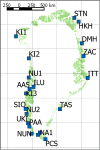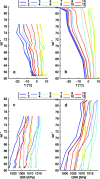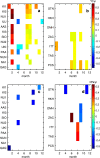Hotspots and key periods of Greenland climate change during the past six decades
- PMID: 28116691
- PMCID: PMC5258655
- DOI: 10.1007/s13280-016-0861-y
Hotspots and key periods of Greenland climate change during the past six decades
Abstract
We investigated air temperature and pressure gradients and their trends for the period 1996-2014 in Greenland and compared these to other periods since 1958. Both latitudinal temperature and pressure gradients were strongest during winter. An overall temperature increase up to 0.15 °C year-1 was observed for 1996-2014. The strongest warming happened during February at the West coast (up to 0.6 °C year-1), weaker but consistent and significant warming occurred during summer months (up to 0.3 °C year-1) both in West and East Greenland. Pressure trends on a monthly basis were mainly negative, but largely statistically non-significant. Compared with other time windows in the past six decades, the period 1996-2014 yielded an above-average warming trend. Northeast Greenland and the area around Zackenberg follow the general pattern but are on the lower boundary of observed significant trends in Greenland. We conclude that temperature-driven ecosystem changes as observed in Zackenberg may well be exceeded in other areas of Greenland.
Keywords: Air pressure trends; Ecosystem changes; Greenland climate change; Temperature trends.
Figures




References
-
- Abermann, J., D. van As, D. Petersen, S. Wacker, and H. Machguth. 2015. Spatial variability of glacier mass and energy balance in West Greenland. In AGU Fall meeting 2015.
-
- Ahlmann HW. Studies in North-East Greenland 1939–1940. Geografiska Annaler. 1942;24:1–22. doi: 10.2307/520078. - DOI
-
- Boas, L., and P.R. Wang. 2011. Quality control of Greenlandic weather and climate data series 1958–2010. Danish Meteorological Institute, TR11-15. Copenhagen, Denmark.
-
- Box JE. Survey of Greenland instrumental temperature records: 1873–2001. International Journal of Climatology. 2002;22:1829–1847. doi: 10.1002/joc.852. - DOI
-
- Burkey, J. 2006. A non-parametric monotonic trend test computing Mann–Kendall Tau, Tau-b, and Sen’s Slope written in Mathworks-MATLAB implemented using matrix rotations. Retrieved 19 May, 2016, from http://www.mathworks.com/matlabcentral/fileexchange/11190-mann-kendall-t....
MeSH terms
LinkOut - more resources
Full Text Sources
Other Literature Sources
Medical
Miscellaneous

